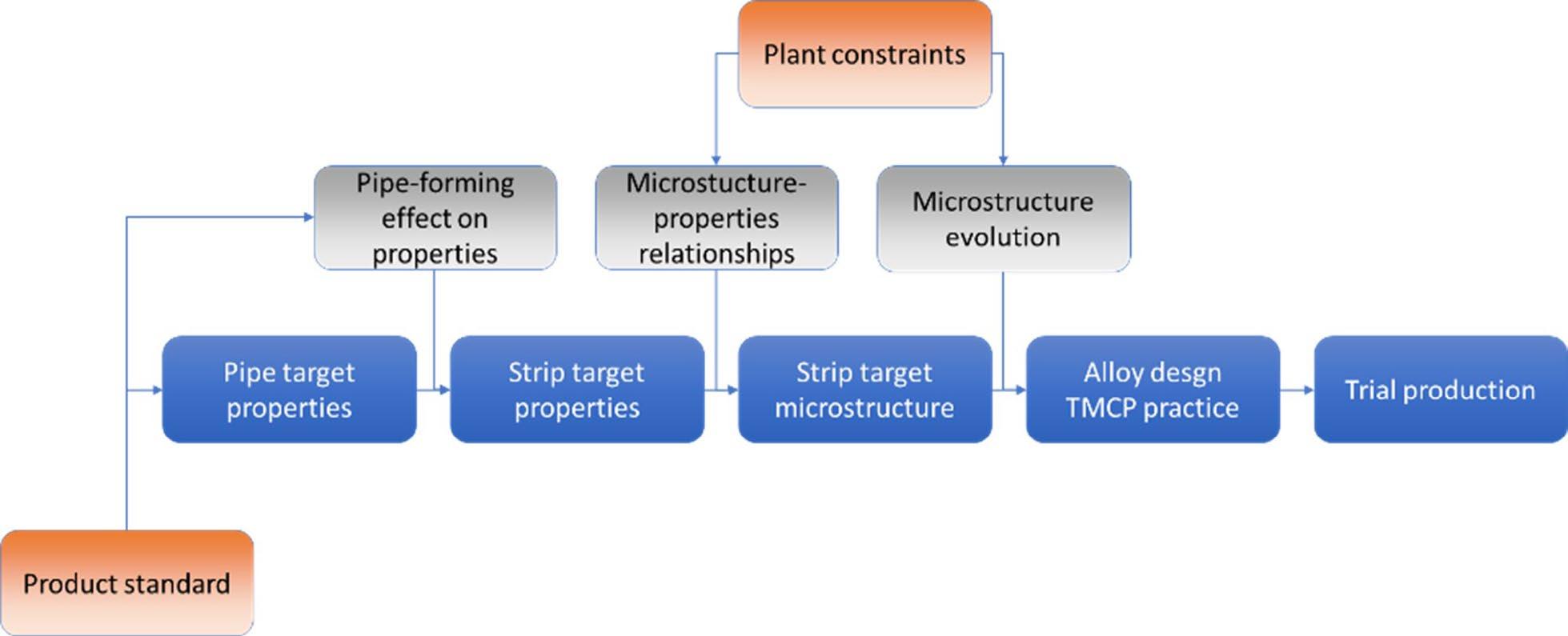
7 minute read
Metallurgical design of x60 steels for gas and hydrogen transport pipes
M. Guagnelli, G. Malatesta, Piero Carone, V. Ruggiero, A. Curci
Most of the actual natural gas infrastructure and next generation hydrogen infrastructure consists of pipelines with small diameters. Therefore, to make the energy transition a reality, the steel industry must respond to the demand for increasingly high-performance materials. The purpose of this article is to show the process of design, development, and production of steels for gas and hydrogen transport pipes. In particular, the present work is focused on the development of grade X60 on typical formats for gas pipeline applications, for which Annex M ISO3183 requires a yield strength to ultimate tensile strength ratio (Y/T) lower than 0.85. In order to achieve an adequate Y/T ratio and toughness on the final product, i.e., the pipe, it is necessary to properly design the chemical composition and final microstructure, and therefore rolling and pipe forming processes. The metallurgical design of these steel grades and their subsequent production were realised thanks to the collaboration between Acciaierie d'Italia (AdI) and the RINA-CSM Rina Consulting - Centro Sviluppo Materiali (CSM). Statistical analysis and metallurgical simulations of mechanical properties evolution were conducted to define the suitable chemical composition, with lower Carbon content, able to satisfy all standard constraints. Industrial tests were conducted by AdI to validate the new alloy design by producing a X60 20’’x12 mm pipe by electrical resistance welding (ERW).
Introduction
Acciaierie d'Italia is working on enhancing the gas transport pipe market. Concerning current energy needs, is under consideration the possibility of using pipes manufactured not only for the transportation of natural gas, but also for mixtures of natural gas and hydrogen. In this context, a preliminary analysis revealed that pipes with X60-X70 grades and relatively low thickness are the most critical products. In fact, AdI's traditional approach for these products was to take advantage of a waiver from the maximum permissible C content for welded tubes, by the standard after agreement with the customer (note j of table A.1 of ISO 3183: 2019) [1].
Considering the possibility of using such pipes for gas transport, although the current standards in this regard do not give specific indications on the permissible carbon content, it was considered appropriate to stick strictly to the limitations indicated in ISO 3183 (Table A.1) [1].
Working in co-operation with RINA Consulting Centro Sviluppo Materiali, a new chemical composition to produce ERW X60ME pipes was designed with the objective of respecting the limitations on carbon content and guaranteeing Y/T values in compliance with the European market requirements.
The approach used to achieve this goal and the results obtained after the first year of operation are the subject of this article.
Metallurgical Design Approach
The typical CSM approach to the metallurgical design of structural steels, schematically described in the Fig.1, was used, and followed in its general lines.
In summary, this approach consists of four successive steps:
- Definition of the target properties on strip from the specified properties on pipe and knowledge of the effect that the pipe forming processes has on the properties;
- Definition of target microstructure from the target properties identified in the previous step and knowledge of the relationship between microstructure and steel properties;
- Definition (or verification) of the rolling and cooling operating practices to be applied to the steel to obtain the microstructure and properties identified in the previous steps;
- Verification by industrial testing of the accuracy of the settings and definition of possible corrective actions.
Fig.1 - Typical CSM approach to the metallurgical design of structural steels.
Definition of the strip target properties
The target properties of the pipe, taken from the standard, are summarised in the Tab.1 and Fig.2. Fig.2 also shows the restriction of the target property win-
Tab.1 - Target properties of pipe and strip.
Target Properties
dow of the strip necessary to account for the loss of mechanical properties when forming the pipe and to compensate the variability due to rolling.
Fig.2 - Target properties windows of pipe and strip.
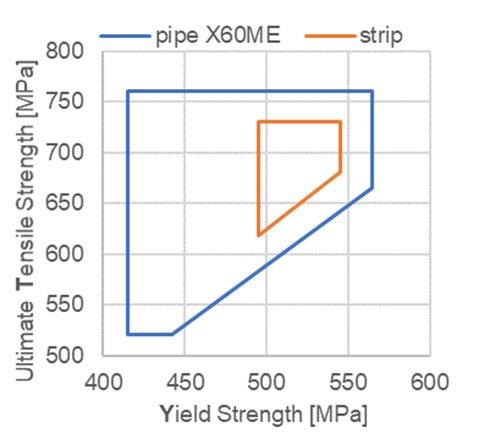
The effect of the pipe forming processes on the mechanical properties was evaluated by analysing historical data and consists in a reduction of about 30 MPa on the average yield strength values (Y) and about 20 MPa on the average ultimate tensile strength values (T). The average Y/T ratio values remain substantially unchanged, as well as the impact toughness values. Regarding the strip properties, a dispersion of ±50 MPa for Y and T and ±0.05 for the Y/T ratio were retrieved from the historical data. Taking these data into account, target properties were defined on strip, summarised in the Tab.1 and Fig.2. Subsequently, it was necessary to define both the microstructure capable of guaranteeing the properties and the rolling and cooling operating practices required to produce the identified microstructure.
Definition of the target microstructure
This step was achieved using semi-empirical relationships linking microstructure and chemical composition to strip properties.
It is known that for carbon steels with a ferrite-pearlite microstructure and limited carbon content (< 0.2% approx.), the mechanical properties can be described by the Hall-Petch equation: where Y and T represent the yield strength and ultimate tensile strength respectively and d is the ferritic grain size characterising the microstructure; the others are coefficients to be derived empirically. Several such equations can be found in the literature where the known term is expressed as a function of the chemical where (PF%), (B%), (MA%) denote the percentages of polygonal ferrite, bainite and martensite, respectively, while the constants a to f were derived by linear regression composition through linear relationships, using coefficients derived by linear regression of experimental data, as well as coefficients describing the influence of grain size. Merging these literature expressions [2 – 4], in the past CSM has developed its own equations, which for micro-alloyed structural steels take the form:
Based on these expressions, considering a value of C ≤ 0.1 and typical values for the other alloying elements and grain size, it was found from initial analysis that the required values of Y/T could not be guaranteed with the ferrite-pearlite structure alone.
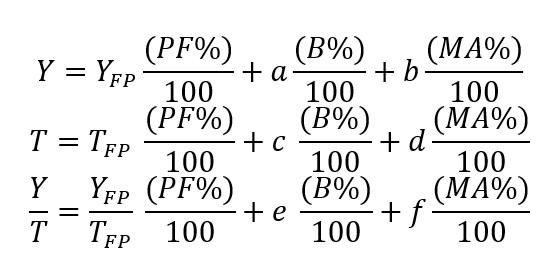
The possibility of exploiting the presence of constituents, such as bainite or martensite, by evaluating their effect on properties through relationships of the type was then assessed:
(1) (2) (3) (4) (5) (6) of CSM historical experimental data, the values of which are shown in Tab.2.

Tab.2 - Values of the constants in equations 4 - 6. CONSTANTS a b c d e f MPa MPa MPa MPa -1066 -409 1483 922 0.52 -0.84
Fig.3 (a) shows the results obtained by applying equations (4) – (6) to the steel grade LC1, used in the past to produce ERW X65ME pipes; in particular, the optimal microstructure should contain between 6 and 12% bainite (B) and between 3 and 5% MA. A new steel grade (LC2) was therefore defined to improve the Y/T value by increasing the Mn and Si content compared to LC1 and reducing the Cr content. With this alternative composition, the optimal microstructure is characterised by a Bainite content between 6 and 12 per cent and a Martensite content between 2 and 4 per cent (see Fig.3 (b)).
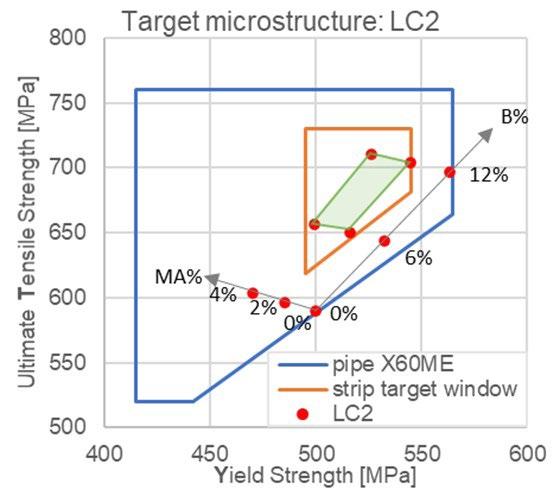
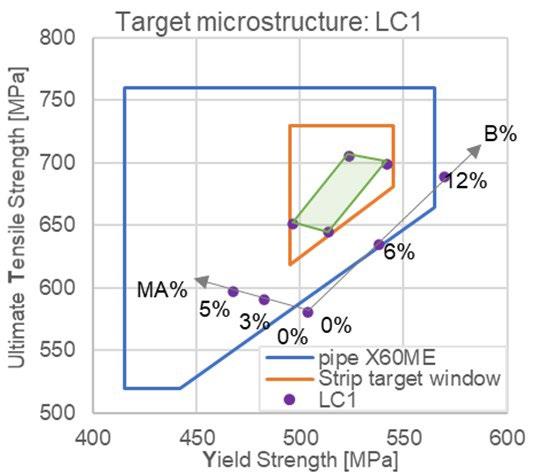
(b) (a)
Fig.3 - Mechanical properties of steel as the microstructural composition changes for steel grades: (a) LC1 e (b) LC2.
Verification of Operating Practices
Once the target microstructures were defined, depending also on the chemical composition, it is necessary to verify that the rolling and cooling operating practices can achieve them. This is usually done by calculating microstructural evolution (recrystallisation during hot rolling and phase transformation during cooling on the ROT). In the present case, a simplified approach was adopted to define the austenite condition at the end of rolling. The simplified approach is based on the following hypothesis: complete recrystallization and neglectable grain grow during roughing, complete strain accumulation in finishing. The austenite condition resulted is a microstructure with a grain size of 25 microns and an accumulated strain of 1.5. The effect of cooling has been calculated by a statistical physical model based on the concepts of nucleation and growth capable of calculating the volume fraction of the different micro-constituents (Ferrite, Perlite, Bainite and Martensite) as well as calculating the ferritic grain size. The cooling rate under the ROT showers was assessed to be 5 °C/s and the coiling temperature was varied between 600 °C (typical value adopted in the past for the steels of interest) and 560 °C (limit value of the system under current conditions).
Different steel grades were considered for these conditions:
- The grade with relatively high C (HC) limited to standard cooling conditions;
- The low-carbon grade already used in the past, but not entirely satisfactory (LC1);
- The optimised steel grade (LC2)
Tab.3 - Results of the microstructural calculation.
Target Properties
Dpf μm B % M % Y MPa T MPa Y/T -
HC 5-600 4.7 0.7 0 501 609 0.82
LC1 5-600 5.5 0 0 491 573 0.86
LC1 5-580 5.5 0 0 491 573 0.86
LC1 5-560 5.5 6.4 0 527 631 0.84
LC2 5-600 5.5 0 0 487 583 0.84
LC2 5-580 5.5 0 0 487 583 0.84
LC2 5-560 5.5 4.5 0 512 623 0.82
Fig.2 - Microstructural target obtained from simulation with AdI standard operating practices.
Industrial tests
To reduce the Y/T ratio, an industrial casting with LC2 steel grade was produced by AdI and a slab was rolled in the hot mill strip. Subsequently, a sample of the coil was taken at 5.5 m from the tail to evaluate microstructure and properties of this. Eleven pipes were obtained from the coil, and they were qualified by the product quality laboratories in Taranto and by the CSM laboratories in Rome.
Fig.5 (a) summarises the obtained results and the Fig.5 (b) shows the microstructure; this clearly consists of a mixture of Polygonal Ferrite and Bainite and possible presence of Martensite, although the content of the different constituents was not estimated. Considering mechanical properties, it appears that the objective has been substantially achieved (Fig.5 (a)) but there is scope for improvement.
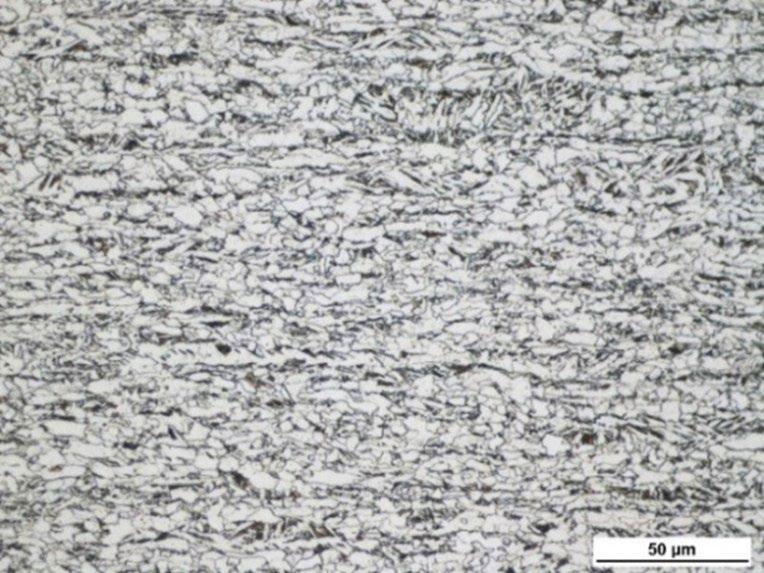
(b) (a)
Fig.5 - (a) Illustration of the target mechanical properties window with tensile stress and yield stress detected on the strip and on the pipe by laboratory tests and (b) obtained microstructure.
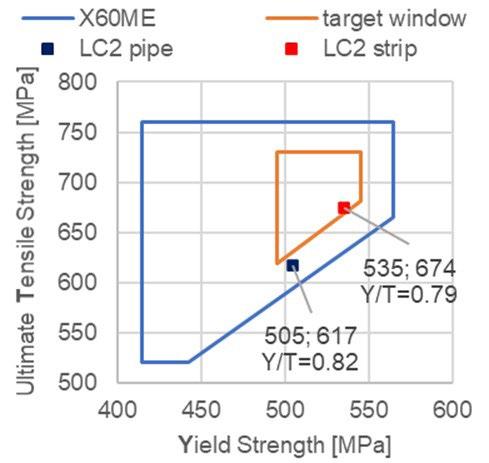
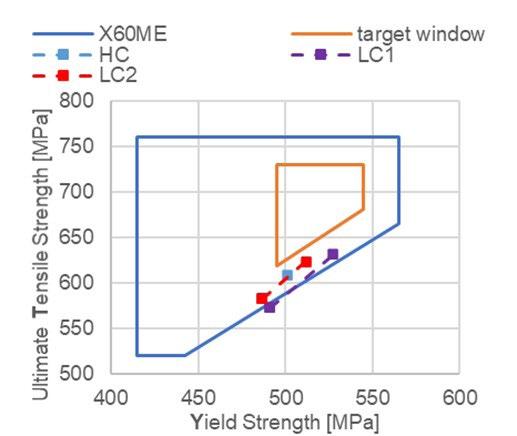
Conclusions
Acciaierie d'Italia and Rina Consulting Centro Sviluppo Materiali are collaborating on the development of natural gas and hydrogen transport steels. CSM's typical approach for metallurgical design of pipe steels was adapted to the case of interest and used to define chemical composition and operating practices that allow to manufacture ERW pipes of grade X60ME, without exceeding 0.12% of the carbon.
Concerning to it, the results of the industrial test are sati-
References
[1] ISO 3183:2019 p. 8;
[2] Hodgson Gibbs, ISIJ Int. 32-12, 1329-1338; sfying for the validation of methodology and the pipes are in compliance with the ISO3183. However, in the future it might be interesting to further investigate the system to: - reduce material yield strength, which is considered high even if in line with standard requirements; - keep, or improve, Y/T values; - contain the mechanical properties dispersion to avoid the risk of non-conformity; - and test the material in hydrogen atmosphere.
[3] European Commission, Directorate-General for Research and Innovation, Gutiérrez, I., Parker, S., Wadsworth, J., Property models for mixed microstructures: final report, Publications Office, 2003;
[4] Pokutylowicz, Collins, Baragar, Yue: Properties-Prediction Model for the Hot Rolling of Long Products, 37th MWSP Conf. Proc., ISS, 1996, Vol. 33, pp427-431.
ALL'INDICE >






